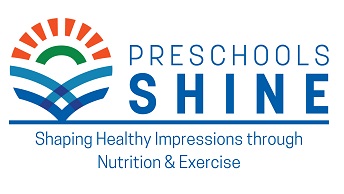SHINE Element 2: Promoting Quality Meals
Overview
Guidance for implementing the criteria for Element 2, Promoting Quality Meals, of the Preschools Shaping Healthy Impressions through Nutrition and Exercise (SHINE) program.
Criteria for Element 2, Promoting Quality Meals
- Implement a minimum of six Smarter Mealtimes strategies from the Smarter Mealtimes Scorecard into the preschool program. To download the Smarter Mealtimes Scorecard (available in English and Spanish), please go to the Smarter Mealtimes Movement (SSM) of CA web page and navigate to the Smarter Mealtimes Resources section.
- Display a minimum of one Smarter Mealtimes in Child Care signage to promote quality meals.
By promoting healthy foods in creative ways, child care staff can make the healthy choice, the easy choice for children. The Smarter Mealtimes in Child Care team developed a list of simple strategies proven to increase children’s selection and consumption of healthy foods. Research shows that:
- Serving a variety of fruits and vegetables increases how much children eat.
- The more times children are served a vegetable, the more likely they are to try it and like it.
- Fun names encourage children to select and eat healthy foods.
- Children selected and ate more vegetables when adult caregivers sat with them and ate the same foods.
Follow the practices below to meet the criteria for Element 2
- Implement a minimum of six of the Smarter Mealtimes strategies from the Smarter Mealtimes Scorecard into the preschool program:
- During at least one meal per day, children are given a choice between at least two types of fruit. Fruits can be fresh, frozen, canned, or dried.
- During at least one meal per day, children are given a choice between at least two types of vegetables. Vegetables can be fresh, frozen, canned, or dried.
- Sliced or cut (not whole) fruit is offered.
- Fruit is offered in attractive bowls or baskets.
- Fruits and vegetables are offered first and at least one additional time during each meal.
- Fruits are called or labeled with fun, creative names.
- Vegetables are called or labeled with fun, creative names.
- Fresh, cut vegetables are frequently paired with a healthy dip.
- The main dish (or featured entrée) is called or labeled with a fun, creative name.
- Taste tests of fruits, vegetables, and main dishes are provided at least once per year.
- Children are given opportunities to learn about food and gardening (e.g., planting a garden, seed planting, farm tours, nutrition education) at least once per year.
- Popular characters (such as Elmo) are used to promote healthy foods using labels or stickers.
- Meals are offered family style.
- Caregivers model healthy eating habits such as sitting with children during meals and eating the provided foods.
- Caregivers announce the menu as part of the daily routine.
- Attractive, healthful food signage (e.g., posters, stickers, or clings) is displayed in the child care environment.
- A weekly or monthly menu is provided to all families.
- Children are encouraged to help with the mealtime set up and cleanup routine.
- All lights in the eating area work and are turned on during meals.
- To help decide what foods are offered, children and families are asked to provide feedback.
- Display a minimum of one Smarter Mealtimes in Child Care signage to promote quality meals available on the Smarter Mealtimes Movement of CA web page:
- Alphabet Fruit and Veggie signage: Colorful, appetizing photographs pair up with ABCs to build literacy skills and create interest in fruits and veggies.
- Smarter Mealtimes in Child Care posters: Instructional posters for adults help caregivers incorporate simple, free Smarter Mealtimes in Child Care strategies into their daily routine.
For resources and useful tools on the Smarter Mealtimes in Child Care initiative, access the Smarter Mealtimes Movement of CA web page. , please email the SMM team at CASmarterMealtimes@gmail.com.

This institution is an equal opportunity provider.
Esta institución es un proveedor que ofrece igualdad de oportunidades.